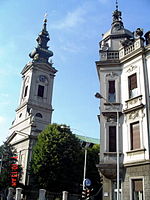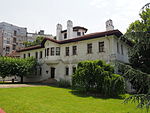The Territory of the Military Commander in Serbia (German: Gebiet des Militärbefehlshabers in Serbien; Serbian: Подручје Војног заповедника у Србији, romanized: Područje vojnog zapovednika u Srbiji) was the area of the Kingdom of Yugoslavia that was placed under a military government of occupation by the Wehrmacht following the invasion, occupation and dismantling of Yugoslavia in April 1941. The territory included only central Serbia, with the addition of the northern part of Kosovo (around Kosovska Mitrovica), and the Banat. This territory was the only area of partitioned Yugoslavia in which the German occupants established a military government. This was due to the key rail and the Danube transport routes that passed through it, and its valuable resources, particularly non-ferrous metals. On 22 April 1941, the territory was placed under the supreme authority of the German military commander in Serbia, with the day-to-day administration of the territory under the control of the chief of the military administration staff. The lines of command and control in the occupied territory were never unified, and were made more complex by the appointment of direct representatives of senior Nazi figures such as Reichsführer-SS Heinrich Himmler (for police and security matters), Reichsmarschall Hermann Göring (for the economy), and Reichsminister Joachim von Ribbentrop (for foreign affairs). The Germans used Bulgarian troops to assist in the occupation, but they were at all times under German control. Sources variously describe the territory as a puppet state, a protectorate, a "special administrative province", or describe it as having a puppet government. The military commander in Serbia had very limited German garrison troops and police detachments to maintain order, but could request assistance from a corps of three divisions of poorly-equipped occupation troops.
The German military commander in Serbia appointed two Serbian civil puppet governments to carry out administrative tasks in accordance with German direction and supervision. The first of these was the short-lived Commissioner Government which was established on 30 May 1941. The Commissioner Government was a basic tool of the occupation regime, lacking in any powers. In late July 1941, an uprising began in the occupied territory, which quickly swamped the Serbian gendarmerie, German police and security apparatus, and even the rear area infantry force. To assist in quelling the rebellion, which initially involved both the communist-led Yugoslav Partisans and the monarchist Chetniks, a second puppet government was established. The Government of National Salvation under Milan Nedić replaced the Commissioner Government on 29 August 1941. Although it enjoyed some support, the regime was unpopular with the majority of Serbs. This failed to turn the tide however, and the Germans were forced to bring in front line divisions from France, Greece and even the Eastern Front to suppress the revolt. Commencing from late September 1941, Operation Uzice expelled the Partisans from the occupied territory, and in December, Operation Mihailovic dispersed the Chetniks. Resistance continued at a low level until 1944, accompanied by frequent reprisal killings, which for some time involved the execution of 100 hostages for every German killed.
The Nedić regime had no status under international law, no powers beyond those granted by the Germans, and was simply an instrument of German rule. Although German forces took the leading and guiding role of the Final Solution in Serbia, and the Germans monopolized the killing of Jews, they were actively aided in that role by Serbian collaborators. The Banjica concentration camp in Belgrade was jointly controlled by Nedic's regime and the German army. The one area in which the puppet administration did exercise initiative and achieve success was in the reception and care of hundreds of thousands of Serb refugees from other parts of partitioned Yugoslavia. Throughout the occupation, the Banat was an autonomous region, formally responsible to the puppet governments in Belgrade, but in practice governed by its Volksdeutsche (ethnic German) minority. While the Commissioner Government was limited to the use of gendarmerie, the Nedić government was authorized to raise an armed force, the Serbian State Guard, to impose order, but they were immediately placed under the control of the Higher SS and Police Leader, and essentially functioned as German auxiliaries until the German withdrawal in October 1944. The Germans also raised several other local auxiliary forces for various purposes within the territory. In order to secure the Trepča mines and the Belgrade-Skopje railway, the Germans made an arrangement with Albanian collaborators in the northern tip of present-day Kosovo which resulted in the effective autonomy of the region from the puppet government in Belgrade, which later formalized the German arrangement. The Government of National Salvation remained in place until the German withdrawal in the face of the combined Red Army, Bulgarian People's Army and Partisan Belgrade Offensive. During the occupation, the German authorities killed nearly all Jews residing in the occupied territory, by shooting the men as part of reprisals conducted in 1941, and gassing the women and children in early 1942 using a gas van.
After the war, several of the key German and Serbian leaders in the occupied territory were tried and executed for war crimes.











